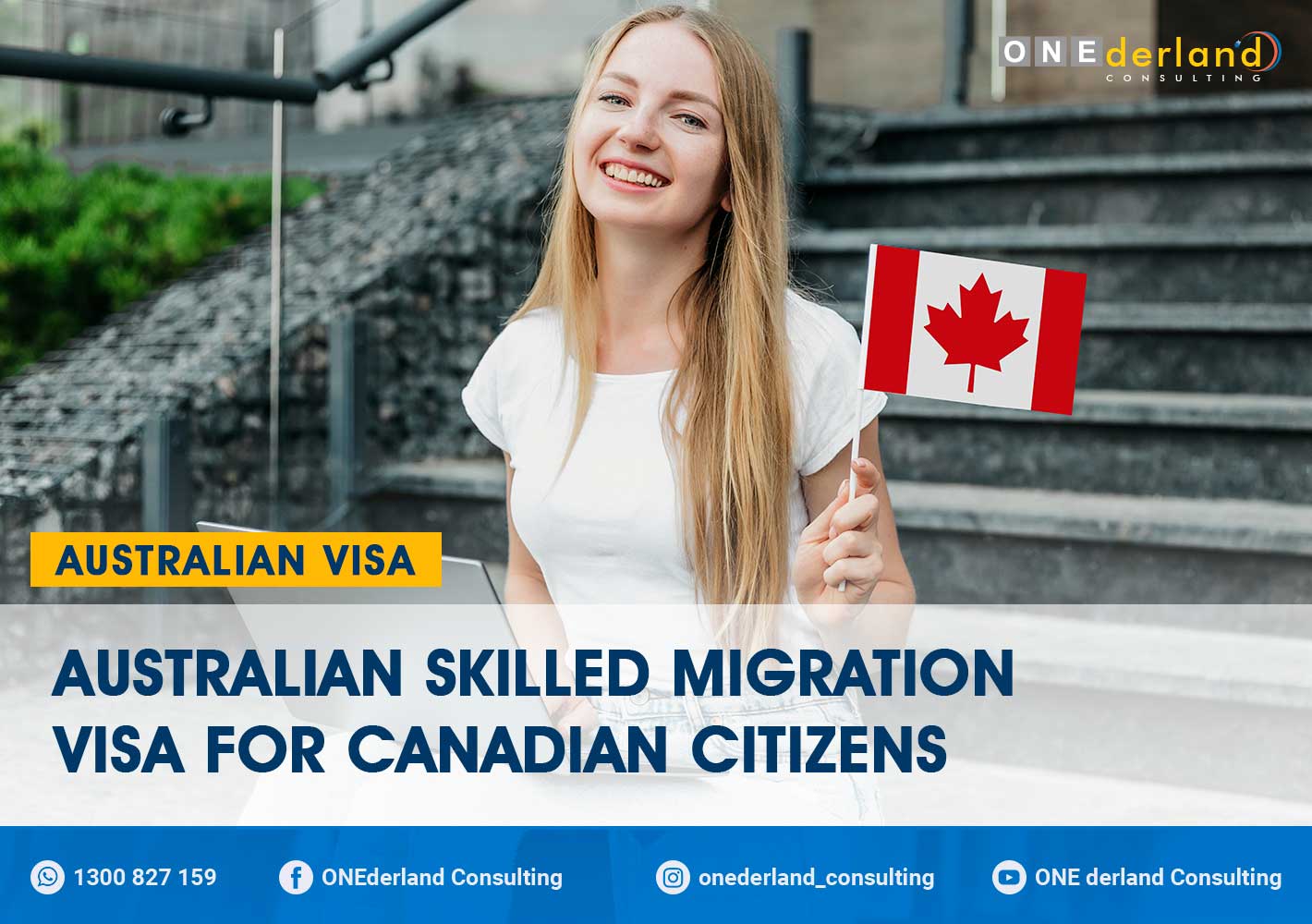How to Obtain Australian Skilled Migration Visa as Canadian Citizens
Are you a Canadian looking forward to migrating to Australia? Well, the Australian Skilled Migration Visa would be a great option for you! The Visa Program offers many benefits, including a direct Australian Permanent Residency for Canadian citizens!
The Australian Skilled Migration Visa program has been one of the favourites for years. There are four visa subclasses under the Australian Skilled Visa, and three of them are point-test based:
- Subclass 189 – the Independent Point-test Based Visa
- Subclass 190 – the State/Territory Nomination Point-test Based Visa
- Subclass 491 – the Temporary Point-test Based Visa for Australian Regional Area
- Subclass 191 – the New Permanent Residency Pathway for 491 and 494 visa holders
We will guide you through all of these visa subclasses, including its requirements, processing steps, and the benefits.
But, First of All, Why Should You Move to Australia?
Obtaining an Australian Permanent Residency and being a Canadian citizen just sounds delightful. And these five factors will appeal to you to migrate to Australia, which are the safety, health & education sectors, cost of living, job opportunities, and wages.
1. Safety in Australia
Australia is considered one of the safest countries in the world. In addition, Australia has a stable political system, comprehensive laws, low crime rates, and a proactive approach to digital security and personal safety. Even since they realise how much they rely on the immigrants, the Government applies strict laws and regulations to all visa programs, including the Australian Skilled Migration Visa.
2. The Education and Health Sectors in Australia
Nonetheless, the education and health sectors are very important, especially when you’re migrating with your family. Talking about the education system, Australia’s education system is ranked eighth in the world, which is high praise indeed. Several of the best universities in the world are located in Australia; one of them is Melbourne University, which sits at number 27 as the best university in the world.
And about the healthcare system, Australia provides free healthcare for its citizens and residents with Medicare. Residents pay a Medicare Levy of 2% of their income to fund public healthcare.
Foreign-born immigrants who are married to an Australian citizen, have a permanent visa, are granted citizenship, or are on a working visa are eligible for the Medicare system, which significantly reduces healthcare costs.
3. Cost of Living in Australia
Australia has the 13th highest cost of living in the world, making it one of the most expensive places to live. Even though living in Australia is more expensive, particularly in relation to real estate given the recent surge in the market, it’s essential to remember that salaries there are significantly higher, especially when you migrate under the Australian Skilled Visa program.
4. Job Opportunities in Australia
Although the job markets in Australia and Canada are both powerful, there are some distinctions in the kinds of jobs that are offered. Canada is a significant centre for manufacturing, energy, and mining.
Australia is also a significant hub for mining and energy production, but it has a role as a significant exporter of agricultural goods and travel-related services.
Not to mention that the agricultural and travel sectors are in demand, so it’s a good opportunity for you to migrate under the Australian Skilled Visa program
5. Wages in Australia
The minimum wage in Australia is AUD 23,23 per hour, or AUD 882,80 per week.
Australia has an average yearly income of $60 355. More experienced workers can make up to $108 467 per year, while entry-level positions typically start at around $57 947. And you can get this too if you migrate with the Australian Skilled Visa program.
Oh, so you need more reasons to migrate to Australia? Duly noted, we have provided the 10 Reasons to Migrate to Australia Permanently
Now, Let’s Dive Into All About the Australian Skilled Visa
So, there are four different visa subclasses under the Australian Skilled Migration Visa program, which are visa 189, visa 190, visa 491, and visa 491. Each of the visa subclasses have different requirements, but the application processes are similar. The very basic requirements you must meet for the Australian Skilled Migration Visa program are:
- Be under 45 years of age;
- Have higher education degree (Advanced Diploma, Diploma, Bachelor, or higher);
- Have relevant work experience for at least 2 or 3 years;
- Pass minimum 65 benchmark points;
- Be invited to apply for the visa
Please note that the Australian Skilled Migration Visa program is a point-test based visa and the points are calculated from each requirement. You must pass at least 65 points to be eligible for the Australian Skilled Migration Visa program.
You can check your point with our online point simulator here.
And you can find the details of each specific requirements, benefits and application processes below.
Requirements for Australian Skilled Visa Subclasses
To ease you in understanding the requirements for each visa subclasses of Australian Skilled Migration Visa, I have compiled them into a table as seen below:
| Visa subclasses | Age requirement | Invitation from State/Territory | Pass 65 benchmark point | Education Qualification | Work Experience Requirement |
|---|---|---|---|---|---|
| Visa 189 | Max. 45 years old | Not Required | Required | Higher education level of minimum Diploma | Relevant work experience of minimum 2 or 3 years |
| Visa 190 | Max. 45 years old | Required | Required | Higher education level of minimum Diploma | Relevant work experience of minimum 2 or 3 years |
| Visa 190 | Max. 45 years old | Required | Required | Higher education level of minimum Diploma | Relevant work experience of minimum 2 or 3 years |
| Visa 190 | Max. 45 years old | Required | Required | Higher education level of minimum Diploma | Relevant work experience of minimum 2 or 3 years |
Or you can check the full requirements here
What are the Differences Amongst These Visa Subclasses?
Each Skilled Visa subclass differs slightly. You can see that the subclass 189 is called an independent point-test based skilled visa, because the subclass 189 does not require an invitation from an Australian state or territory Government.
Meanwhile, the subclass 190 and 491 require you to be invited by the Australian State or Territory Government before lodging the visa application. For this, you will have an additional point of 5 in your Expression of Interest application.
There is also a unique fact about the subclass 491 visa that there is a stream under subclass 491 that allows your family members to nominate you working in Australia under the subclass 491.
Read this article for more information about the Family Sponsored stream of Visa 491.
The only visa subclass that does not require you any invitations or passing the 65 benchmark point is the subclass 191. The subclass 191 just commenced in November 2022 and works as the Australian Permanent Residency pathway for the holders of subclass 491 and subclass 494. So, the main requirement for the subclass 191 is to hold a valid subclass 491 or subclass 494.
For the details of subclass 191 visa, check this out: Subclass 191 – Permanent Residence (Skilled Regional) Visa
For the details of subclass 191 visa, check this out: Subclass 191 – Permanent Residence (Skilled Regional) Visa
Skilled Visa Application Processes
Unlike other skilled visas, the Australian Skilled Migration Visa program is based on a point test, so there are additional processes you have to pass, called Expression of Interest (EOI) application. So, the process of submitting an Australian Skilled Visa application would be:
1. Australian Skills Assessment
Skills Assessment is mandatory for all Australian Skilled Visa applications. The purpose of Skills Assessment is to ensure that your qualifications and work experience are equal to the Australian standards.
You should obtain a positive outcome from the Skills Assessment and it should be done with the respective Skills Assessing Authority based on your nominated occupation. You can check the Skills Assessing Authority here.
2. Expression of Interest Application
After completing and getting a positive outcome from your Skills Assessment, the next step for your Australian Skilled Migration Visa application is lodging the Expression of Interest (EOI) application. There is an online portal called SkillSelect to submit your application.
You must complete all information about yourself, including your age, work experience, qualifications, skills assessment result, marital status, etc. Then, the Australian Government will assess your application based on the information and the application will show you how many points you have.
3. Invitation from Australian Federal or State/Territory Government
The invitation will come to you only if you have passed at least 65 points. However, it does not mean that 65 points are enough to get the invitation.
You can check the latest invitation round to see the minimum point for each nominated occupation to be invited, or find the tips to improve your points here.
And if you have received the invitation, you will have 60 days to submit your Australian Skilled Visa application, which is the final step in getting your Australian Permanent Residency!
4. Australian Skilled Visa Application
You must lodge your Australian Skilled Visa application within the given time frame. You can lodge your application through an online portal called Immi Account.
Ensure that your documents are still valid, especially the Skills Assessment considering it has a validity period for up to 3 years. You must also ensure that the information matches with your EOI application.
Benefits of Lodging Australian Skilled Visa as Canadian Citizens
Lodging an Australian Skilled Visa as a Canadian citizen offers you many benefits, including not being required to provide English Proficiency Certificate, a direct Australian Permanent Residency pathway, etc.
1. No English Proficiency Certificate Required
Unlike candidates from other countries, as a Canadian citizen, you will get the benefit of not being required to provide an English Proficiency certificate to your Australian Skilled Visa application.
So, you are one step ahead.
2. Direct Australian Permanent Residency Pathway
As mentioned above, the Australian Skilled Migration Visa offers you a direct Australian permanent residency for Canadian citizens, especially if you apply for the Visa 189 or Visa 190.
Being a citizen of Canada and an Australian Permanent Resident sounds interesting, right?
3. Higher Wage in Australia
Australia offers a higher wage compared to Canada. The average wage in Canada in 2021 was $59 300, which indicates to $29,47 per hour or $4 942 per month. Meanwhile, Australia has an average yearly income of $60 355. More experienced workers can make up to $108 467 per year, while entry-level positions typically start at around $57 947.
Convinced Enough to Migrate to Australia?
So, what do you think about getting an Australian Permanent Residency and being a Canadian citizen? Convinced enough to migrate with the Australian General Skilled Visa? Let’s catch up on the best visa subclass for you and plan the migration process strategically with our migration agent. We offer a 100% money back guarantee if you’re not satisfied with our service!








